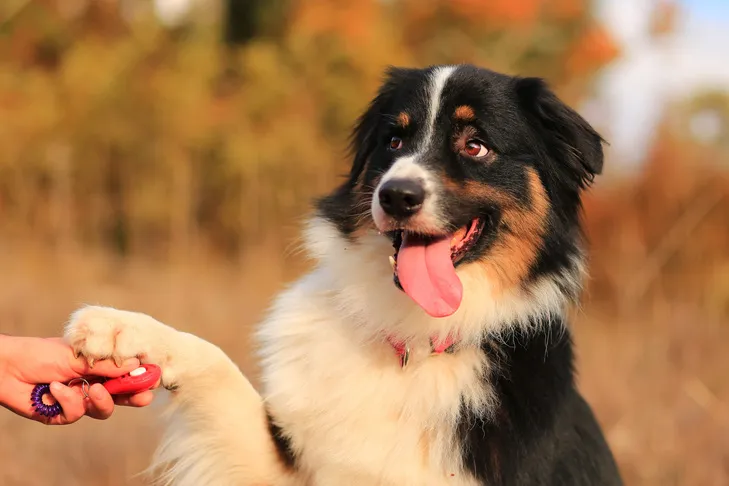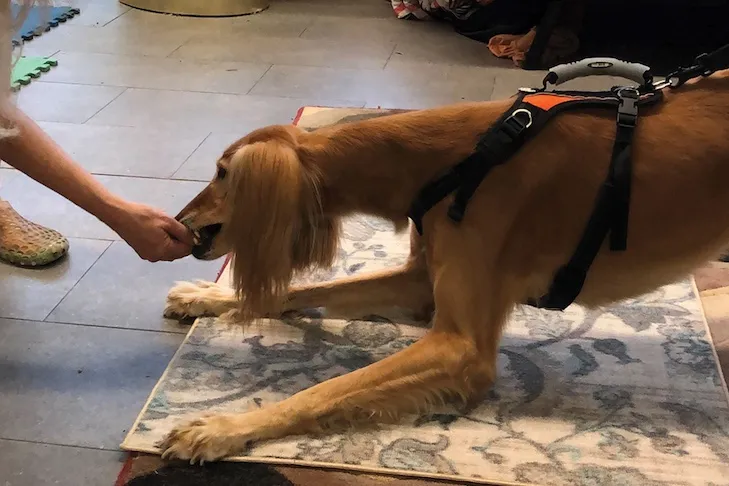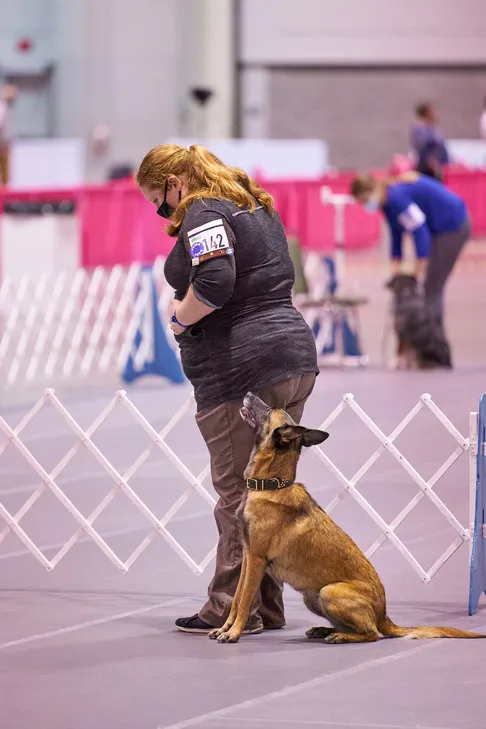Are you ready to impress your friends and family with your dog’s incredible trick skills? Learning advanced dog tricks is a fantastic way to bond, mentally stimulate your canine companion, and even prepare them for various adventures, whether it’s a trip to the park or even utilizing services like uber for dog walking for their next outing. Once mastered, these New Dog Tricks To Teach are not only fun to show off but can also count towards earning prestigious AKC Trick Dog titles, highlighting your dog’s intelligence and your effective training methods.
For these engaging training sessions, you’ll primarily need three things: patience, time, and the right motivators. Make sure to have plenty of high-value dog treats on hand, and some favorite toys if your dog is toy-motivated. If you incorporate a clicker into your training routine, keep it ready to mark the precise moment your dog performs the desired behavior. Additionally, choosing a quiet, distraction-free environment will significantly help both you and your pet focus and succeed.
How to Teach “Catch”
Teaching your dog to catch is a rewarding trick that improves their coordination and responsiveness. Begin with your dog sitting directly in front of you, ensuring you have their full attention with a treat. Gently toss a treat using an underhanded throw, aiming for their mouth. If your dog successfully catches the treat, offer enthusiastic praise immediately. If they miss, try to quickly retrieve the treat before they can eat it off the ground, and attempt the toss again.
 A happy Labrador Retriever ready to catch a tennis ball thrown by its owner in a green field.
A happy Labrador Retriever ready to catch a tennis ball thrown by its owner in a green field.
Repeat this exercise several times during each training session. Once your dog consistently catches tossed treats, you can gradually introduce lightweight toys they enjoy. When your dog catches their toy, lavish them with praise and follow up with a treat as a reward. This positive reinforcement strengthens their understanding and enjoyment of the trick.
How to Teach “Under the Bridge”
“Under the Bridge” is a delightful trick where your dog crawls under your raised knees, resembling a bridge. To start, sit on the floor with your knees bent and raised to form a triangular shape. Ensure you have treats or a toy that your dog finds highly exciting. Position your dog on one side of your body, holding the treat or toy in your hand on the opposite side. Reach the treat or toy under your legs and allow your dog to sniff it, building their interest.
Then, slowly lower the treat or toy towards the ground, guiding it under your legs. As your dog follows the lure, they will naturally lower their body and crawl through the “bridge” formed by your legs. Once they emerge on the other side, praise them enthusiastically and reward them with the toy or treat.
After a few repetitions, you can introduce a verbal cue of your choice, such as “under” or “bridge,” as your dog performs the action. When your dog consistently performs this trick, you can begin to phase out the physical lure. Simply give the verbal cue, and then praise and treat your dog after they successfully crawl under your legs.
How to Teach “Speak”
Teaching your dog to “speak” on command is a fun way to engage with them and can even be useful in certain situations. The easiest method for this trick is “capturing,” where you reward a naturally occurring behavior and then associate it with a cue over time.
To teach your dog to speak, have treats readily available. Whenever your dog naturally barks, perhaps out of excitement or to get your attention, immediately mark the barking with a chosen cue (like “talk” or “speak”) and give them a treat. Using a clicker can be particularly effective here, as it allows you to mark the exact moment of the bark, helping your dog understand precisely what action earned the reward.
 A Dachshund in a grassy yard, barking with enthusiasm while looking upwards.
A Dachshund in a grassy yard, barking with enthusiasm while looking upwards.
After several repetitions of marking and rewarding, your dog will begin to understand that you’re looking for them to bark. To prevent excessive or unwarranted barking, it’s crucial that once your dog grasps the trick, you only reward them when they bark specifically in response to your verbal cue. This helps them differentiate between general barking and performing the “speak” command.
How to Teach Leg Weaves
Leg weaves are an impressive and dynamic trick that showcases your dog’s agility and your bond. Start in a safe, open area without a leash to avoid any tangling. Stand with your legs wide apart and have your dog in front of you. Hold a treat in one hand behind your legs, which will allow you to lure your dog through and around your legs naturally, rather than pushing them from the front. Bend your knees slightly and use the treat to guide your dog to walk between your legs. As your dog passes through, offer praise and a treat.
Once your dog is comfortable with this initial movement, use another treat to guide them through your legs and then around one leg until they return to stand in front of you. Allow your dog to lick and nibble at the treat as you lure them to maintain their focus and position. When they complete the full movement and return to the starting position, praise and treat them.
After your dog confidently follows the treat through your legs and around one side, repeat the same steps to teach them to go through and around your other leg. When your dog consistently follows the lure between your legs and around both legs individually, it’s time to link these movements into a figure-eight pattern.
Begin by luring your dog between your legs and around your right leg, then immediately around your left leg, before rewarding them with a treat. Next, you can gradually “fade” out the treat lure by using an empty hand to guide your dog between and around your legs. Once your dog can weave following your empty hand, introduce your chosen verbal cue, such as “weave” or “legs.” With more repetitions, you can eventually phase out the empty-handed lure entirely, as your dog will begin to recognize your bending-knee body language as the physical cue for the trick.
Once your dog has mastered leg weaving while you are standing still, you can advance to teaching them to leg weave while you walk forward. Start by taking large, slow steps as you give your dog the cue to weave. As you introduce movement, reintroduce the treat lure temporarily to help build your dog’s confidence with this new challenge. As your dog gains experience, you can gradually phase out the lure again and begin to walk faster with smaller steps, polishing the trick to a smooth, flowing performance.
How to Teach Your Dog to Shake Hands
Teaching your dog to “shake hands” is a classic and charming trick that many owners love. To begin, extend an open hand towards your dog. Initially, ignore any licking or sniffing of your hand. Wait patiently until your dog paws at your hand. The instant they do, mark that behavior with praise or a clicker, and promptly give them a treat. Repeat this process until your dog consistently paws at your outstretched hand.
 An Australian Shepherd gently placing its paw on its owner's hand during a training session outdoors.
An Australian Shepherd gently placing its paw on its owner's hand during a training session outdoors.
Next, you’ll work on building the duration of your dog’s paw resting on your hand. To do this, wait for a second or two after their paw touches your hand before clicking or praising and then rewarding them. Gradually increase the amount of time you wait as your dog understands that the sustained contact earns the reward.
Once your dog consistently places their paw on your hand and waits for the reward, introduce a verbal cue of your choice, such as “shake” or “hello.” At this stage, you’re also ready to flatten your hand and hold it vertically, with the treat nestled in it, mimicking the gesture of shaking someone’s hand. Begin to introduce a gentle, up-and-down movement with your hand before treating your dog, further refining the “shake” action.
How to Teach “Yes” and “No”
This advanced trick makes it seem as though your dog can intelligently answer “yes” or “no” to your questions, which is sure to delight onlookers.
To teach your dog to “say yes,” hold a high-value treat in a closed fist (or use a simple, distinct hand signal you prefer). Slowly move the hand holding the treat lure up and down, encouraging your dog to follow the lure with their nose, which will result in a nodding motion. As soon as they nod, reward them with the treat.
Once your dog consistently follows your fist with a nodding motion, try performing the same action without a treat in your hand. When your dog nods, praise them and immediately provide a treat with your other hand. After some practice, your closed fist will become the physical cue for your dog to nod their head, and you can gradually phase out the up-and-down movement of your fist.
To teach your dog to “say no,” you’ll use a similar capturing and luring approach but with a different signal and motion. Instead of just a closed fist, use a distinct hand signal such as a closed fist with your pointer finger extended upwards. To teach them to shake their head, you’ll move your hand slowly from side to side. As your dog follows your hand, their head movement will resemble a shake. When your dog moves their head to follow your hand, praise and treat them. With consistent practice, the extended pointer finger will become the physical cue for your dog to shake their head in response.
How to Teach Your Dog to “Bow”
The “bow” is an elegant trick that also offers physical benefits, serving as a good stretch and strength-building exercise for your dog. Begin with your dog standing directly in front of you. Capture their attention with a treat held in your hand. Then, use the treat to lure their nose down between their front legs and back towards their chest and belly. As your dog follows the treat lure, they will naturally move into the bowing position, with their front end down and hindquarters up. Praise and treat your dog immediately. To prevent them from simply going into a full “down” position, toss a treat away from them to encourage them to stand up and move after completing the bow. Repeat this over several practice sessions.
While luring the dog’s nose between their front legs works for many pets, some dogs might collapse directly into a “down” instead of a bow. If this occurs, Penny Leigh, CPDT-KA, Director of the AKC GoodDog Helpline (GDH), suggests trying a different approach: gently place a hand or even just a finger lightly on your dog’s stomach, just below their loin, to subtly cue them that you are not asking for a full “down.”
 A dog performing a bow, stretching its front legs forward while keeping its hindquarters raised, a great exercise.
A dog performing a bow, stretching its front legs forward while keeping its hindquarters raised, a great exercise.
Once your dog consistently follows the food lure into the bow position, transition to luring them with an empty hand. Continue to treat your dog after they have successfully performed the bow. When your dog reliably follows the empty-hand lure, you can introduce a verbal cue of your choice, such as “bow” or “fancy.” With consistent practice, your dog will build the strength and coordination needed to hold the bow longer. You can also gradually phase out your physical hand lure, and over time, evolve the physical cue for this trick to you performing a slight bow or curtsy yourself, making it a truly interactive and sophisticated trick.
How to Teach Your Dog to Make a “Circle”
Teaching your dog to spin in a circle is a simple yet engaging trick that demonstrates their ability to follow a motion cue. To teach your dog to spin, first get their attention with a treat or a favorite toy. Hold the lure just above your dog’s nose and then slowly move your hand in a large, circular motion. As your dog follows the treat or toy with their nose, they will naturally walk in a circle. Praise and treat your dog as they complete the circle. After a few repetitions, when your dog consistently follows the lure in a circle, you can add in your verbal cue of choice, such as “spin,” “twirl,” or “around.”
Next, use the exact same technique to lure your dog to spin in the opposite direction. When your dog consistently follows your lure to spin the other way, introduce a separate verbal cue for this direction if you wish, or simply use the same cue if you want them to choose. Once your dog is consistently following your cue to spin in both directions, you can begin to use the circular hand motion without a treat in your hand, while simultaneously giving your verbal cue. When your dog spins, praise and treat them, reinforcing their understanding of the command.
How to Teach Your Dog to Play “Peekaboo”
The “Peekaboo” trick is a practical and charming skill, especially useful if you need your dog to stay close to you in tight spaces. To teach your dog Peekaboo, start by standing in front of your dog, with both of you facing the same direction. Hold a treat in your hand to capture their attention. When your dog comes forward and positions themselves between your legs, offer immediate praise and a treat.
 A small dog performing the "peekaboo" trick, standing between its owner's legs, looking forward.
A small dog performing the "peekaboo" trick, standing between its owner's legs, looking forward.
After a few repetitions, you can introduce a verbal cue of your choice, such as “middle” or “peekaboo,” as your dog moves between your legs. Once your dog is in position between your legs, use your chosen release cue (if you have one) or simply toss a treat away from you to encourage them to move out of position, preparing for the next practice round. As you continue to practice, you’ll be able to gradually fade out the need to lure your dog forward with a treat, and they will reliably respond to the verbal cue to come into the “Peekaboo” position, making this a truly useful and fun trick.
Training your dog to perform these exciting new tricks is an incredibly rewarding experience that strengthens your bond and boosts your dog’s confidence. Remember, consistency, positive reinforcement, and patience are key to success. Each new trick mastered is a testament to your dedication and your dog’s amazing capacity to learn. Keep these tips in mind, and enjoy the journey of discovering what incredible things your canine companion can achieve!
